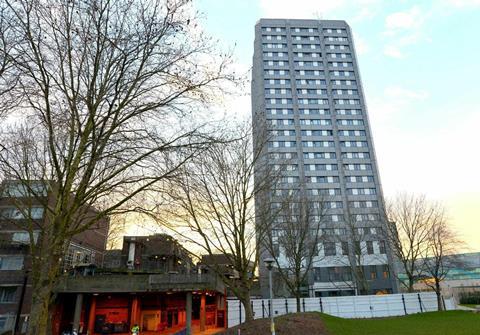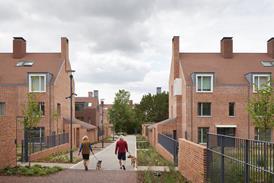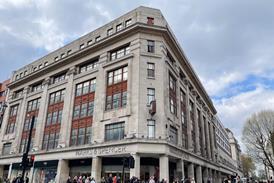Studio E’s as-built Grenfell drawings ‘had wrong date and materials’
Harley Facades marked Grenfell cladding drawings “approved for construction” even before they had been seen by architect Studio E, the Grenfell Inquiry has been told.
Subsequent drawings marked “as-built” by Studio E contained errors such as referring to zinc cladding despite this being swapped out for cheaper aluminium in a cost-cutting process long before construction work had even begun.
Main contractor Rydon’s senior manager on the project, Simon Lawrence, admitted this was a “serious mistake” under questioning from inquiry barrister Richard Millett QC.
Inquiry chairman Martin Moore-Bick then asked him: “The drawing bears the date 26 September 2013. What had been built by then?”
Lawrence responded: “Nothing. I would suggest it – that Studio E have taken an original tender drawing and have just put it in the pack of as-builts without checking it and/or updating it.”

The inquiry was also shown drawings sent by Harley to Studio E for checking.
Millett asked Lawrence: “Do you know why it was marked ‘approved for construction’ before Studio E had even commented on this drawing?”
Lawrence said: “I don’t definitively know why, but I would assume that it was a Harley internal process to say it’s ready to go out to be checked, but that would be my guess.”
He said he had never asked either of Rydon’s specialist designers – Harley or Studio E – why they were doing this.
Millett established that the schedule of architectural services drawn up between Rydon and Studio E “promised to ensure that all designs complied with the relevant statutory requirements” including Building Regulations.
The inquiry heard that Studio E associate Neil Crawford would stamp drawings “conforms with architectural intent”.
Millett asked Lawrence: “Did you ever discuss with Neil Crawford how his ‘architectural intent’ stamp … would operate as an indication that he was satisfied that the design complied with the Building Regulations?”
Lawrence said: “No, I don’t – no, I don’t believe had a specific conversation about it, no.”
Millett then asked: “Unless you had made sure that Studio E was doing rather more than just checking for architectural intent, but actually making sure that the designs they stamped were compliant with the Building Regulations, how could you be sure that you, Rydon, were giving the TMO what you, Rydon, had promised under your contract with the TMO?”
Lawrence replied: “Because we had the building control as well that were one of the third-party obviously checkers and signing off [sic]. So we had several layers of checking of the information.”
Millett asked: “To your knowledge, did building control check the designs marked by Studio E before they proceeded to construction?”
Lawrence said if not then he would have expected them to be signed off shortly afterwards.
Millett replied: “Right. Did you realise that by laying off to trusted subcontractors the job of ensuring that all designs complied with statutory requirements, and if Rydon had no means of supervising or checking that the work had been done properly, Rydon was assuming a risk of non-compliance and therefore breach of contract with the TMO?”
Lawrence said: “Well, all the works would be – would be checked and signed off before completion and would be checked by building control at the very least and others as the works progressed. So I don’t think there was ever any thought that we would not be compliant and we would not be fulfilling our obligations to the TMO.”
Asked if it wasn’t “a little bit late” to leave it to building control to sign off, Lawrence said they employed subcontractors who they believed to be competent specialists in their fields and that there were “layers of quality control and checking” in place.
Millett pressed him, saying: “At the moment when a drawing which had come from Harley and been seen and stamped ‘A’ by Studio E then proceeded to construction, none of the checks you’re referring to – building control, clerk of works – had been applied to that drawing?”
Lawrence replied: “They may not have been to every drawing at that time, no.”
Millett later showed the inquiry an email trail and construction drawings from Harley that he said appeared to show there had been “no confirmation either from Rydon or Studio E that they even conformed with architectural intent, let alone that they were compliant with the statutory requirements”.
Elsewhere in his evidence, Lawrence was asked about Rydon’s failure to use a fire consultant despite minutes of project meetings showing he had promised to look into novating fire specialist Exova which had been used by Studio E to produce an outline fire strategy at tender stage in November 2013.

This document contained the sentence: “It is considered that the proposed changes [which Lawrence said he understood to mean the cladding] will have no adverse effect on the building in relation to external fire spread but this will be confirmed by an analysis in a future issue of this report.”
The confirmation never came. Lawrence could not explain why he had not chased it.
The inquiry heard Rydon had chosen not to reconsider its custom of not hiring fire specialists even after 2012 when fire had broken out at Chalcots Estate in north London, a previous Rydon high-rise overcladding project.
Millett asked him: “If Rydon had no in-house design expertise, on what basis could the Rydon in-house team decide they didn’t need a fire safety consultant?”
Lawrence said they felt they were getting a “very good service” from building control.
Millett pointed out that building control was a regulator and not part of Rydon’s subcontractor chain.
He said: “They were external to the entire Rydon subcontract chain so you might expect them to pick up any non-compliances but is it really right to say that Rydon were relying on them as though they were part of the subcontractor chain, providing you with a service?”
Lawrence said: “Well, they were providing us with a service. We were paying for them to check compliance against the building regs and then check the work that was installed.”
On the first day of his evidence to the inquiry into the fire that claimed 72 lives, Lawrence’s response to a series of questions about how Rydon intended to ensure the project was safe was that the firm relied on specialist subcontractors and designers.
The inquiry continues.
















No comments yet